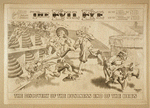"Iron Bones Giving Birth to Spring"
"Learning from Bamboo's Lofty Spirit Though it is Hollow;
Following the example of Plum Blossoms Which Bloom on Iron Boughs"
"Before Peach and Pear Trees Come into Bloom, Winter
Plum Blossoms Spring out of Iron-like Trunks"
"Tested by Wind and Frost, Plum Blossoms Smell Stronger;
People Who Expect Nothing Have More Noble Quality"
---Wang Chengxi, titles from his paintings, collected in A Hundred Plum Blossom Paintings (1992)
Wang Chengxi, a contemporary painter of plum blossoms, continues a tradition in existence since the Tang Dynasty. In explaining his interest in the plum blossom, Chengzi echoes those of the artists and poets who preceded him who appropriated the plum blossom to signify the coming of spring in both the literal as well as the more figurative sense--rejuvenation after a difficult time, such as illness. Chengxi writes, "Braving snow and frost, plum trees blossom defiantly to spread their fragrance . The noble character and morals of the people can be likened to plum blossoms which are burst forth in adverse circumstances and bring encouragement to the world."
The plum blossom is one of the "Three Friends of the Cold" (which includes pine and bamboo, mentioned above) as well as one of "The Four Gentlemen" , which includes orchid (spring) bamboo (summer) and chrysanthemum (autumn). The plum blossom is an example of what we might call the spiritual underpinnings of the material world. The strength of the plum tree's "iron bones" which bring forth blossoms in abundance even amidst cold and ice offers us a narrative of resurrection.
Tomorrow's entry will feature plum blossoms once more to celebrate the advent of spring.
Subscribe to:
Post Comments (Atom)






No comments:
Post a Comment